文章目录
- 1. 二叉树之层序遍历
- 1.1 144-二叉树的前序遍历
- 1.2 94-二叉树的中序遍历
- 1.3 145-二叉树的后序遍历
- 1.4 102-二叉树的层序遍历
- 1.5 107-二叉树的层序遍历II
- 1.6 199-二叉树的右视图
- 1.7* 637-二叉树的层平均值
- 1.8* 429-N叉树的层序遍历
- 1.9 515-在每个树行中找最大值
- 1.10* 116-填充每个节点的下一个右侧节点指针
- 1.11 117-填充每个节点的下一个右侧节点指针II
- 1.12 104-二叉树的最大深度
- 1.13 111-二叉树的最小深度
- 2. 二叉树之常见算法
- 2.1 226-翻转二叉树
- 2.2 101-对称二叉树
- 2.3* 222-完全二叉树的节点个数
- 2.4 110-平衡二叉树
- 2.5 257-二叉树的所有路径
- 2.6 404-左子叶之和
- 2.7* 513-找树左下角的值
- 2.8 112-路径总和
- 2.9* 106-从中序与后续遍历序列构造二叉树
- 2.10* 105-从前序与中序遍历序列构造二叉树
- 2.11* 654-最大二叉树
- 2.12 617-合并二叉树
- 2.13* 236-二叉树的最近公共祖先
- 3. 二叉搜索树
- 3.1 700-二叉搜索树中的搜索
- 3.2* 98-验证二叉搜索树
- 3.3 530-二叉搜索树的最小绝对差
- 3.4 501-二叉搜索树中的众数
- 3.5* 235-二叉搜索树的最近公共祖先
- 3.6* 701-二叉搜索树中的插入操作
- 3.7* 450-删除二叉搜索树中的节点
- 3.8* 669-修剪二叉搜索树
- 3.9 108-将有序数组转换为二叉搜索树
- 3.10 538-把二叉搜索树转换为累加树
1. 二叉树之层序遍历
1.1 144-二叉树的前序遍历
144

/*** Definition for a binary tree node.* struct TreeNode {* int val;* TreeNode *left;* TreeNode *right;* TreeNode() : val(0), left(nullptr), right(nullptr) {}* TreeNode(int x) : val(x), left(nullptr), right(nullptr) {}* TreeNode(int x, TreeNode *left, TreeNode *right) : val(x), left(left), right(right) {}* };*/
class Solution {
public:void Recursion(TreeNode* root,vector<int>& ans){if(root == nullptr)return;ans.push_back(root->val);Recursion(root->left,ans);Recursion(root->right,ans);}vector<int> preorderTraversal(TreeNode* root) {vector<int> ans;Recursion(root,ans);return ans;}
};
迭代难度更大
class Solution {
public:vector<int> preorderTraversal(TreeNode* root) {vector<int> ans;stack<TreeNode*> st;TreeNode* cur = root;while(cur || !st.empty()){while(cur) //第一趟把左列节点放入栈和ans{ans.push_back(cur->val);st.push(cur);cur = cur->left;}TreeNode* tmp = st.top(); //对应着左下角的节点st.pop();cur = tmp->right; //开始右}return ans;}
};
1.2 94-二叉树的中序遍历
94
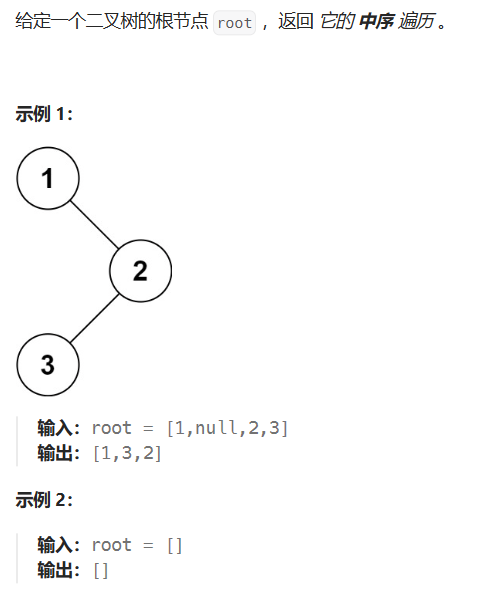
class Solution {
public:void Recursion(TreeNode* root,vector<int>& ans){if(root == nullptr)return;Recursion(root->left,ans);ans.push_back(root->val);Recursion(root->right,ans);}vector<int> inorderTraversal(TreeNode* root) {vector<int> ans;Recursion(root,ans);return ans;}
};
迭代法
class Solution {
public:vector<int> inorderTraversal(TreeNode* root) {stack<TreeNode*> st;vector<int> ans;TreeNode* cur = root;while(cur || !st.empty()){while(cur){//ans.push_back(cur->val); 并不是最左边的数据放在第一个st.push(cur);cur = cur->left;}TreeNode* tmp = st.top();ans.push_back(tmp->val); st.pop();cur = tmp->right;}}
};
1.3 145-二叉树的后序遍历
145
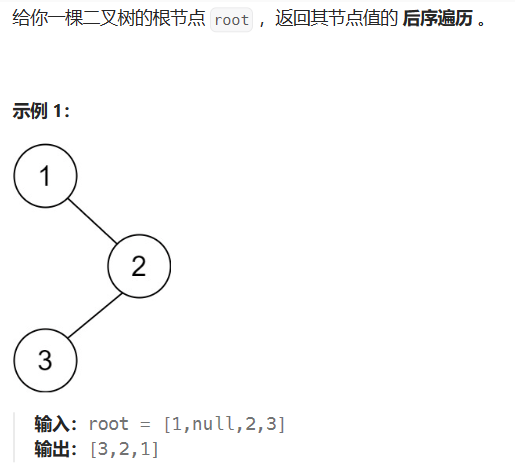
class Solution
{
public:void Recursion(TreeNode*& root,vector<int>& ans){if(root==nullptr)return;Recursion(root->left,ans);Recursion(root->right,ans);ans.push_back(root->val);}vector<int> postorderTraversal(TreeNode* root) {vector<int> ans;Recursion(root,ans);return ans;}
};
迭代法
class Solution {
public:vector<int> postorderTraversal(TreeNode* root) {vector<int> ans;stack<TreeNode*> st;TreeNode* cur = root;TreeNode* prev = nullptr;while(cur || !st.empty()){while(cur){st.push(cur);cur=cur->left;}TreeNode* top = s.top();if(!top->right || top->right == prev){ans.push_back(top->val);prev = top;st.pop();}elsecur = top->right; //当左走完之后这一步可以走到右}return ans;}
};
1.4 102-二叉树的层序遍历
102
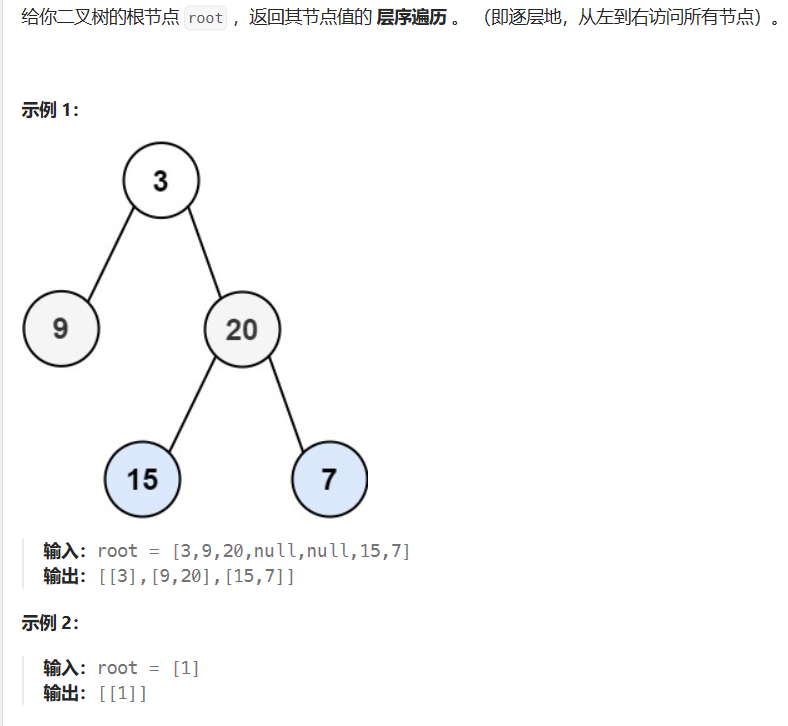
class Solution {
public:void Recursion(vector<vector<int>>& ans,TreeNode* root,int level){if(!root)return;if(ans.size() <= level) //ans的层数不够,加层数ans.push_back(vector<int>());ans[level].push_back(root->val);Recursion(ans,root->left,level+1);Recursion(ans,root->right,level+1);}vector<vector<int>> levelOrder(TreeNode* root) {vector<vector<int>> ans;Recursion(ans,root,0);return ans;}
};
1.5 107-二叉树的层序遍历II
107
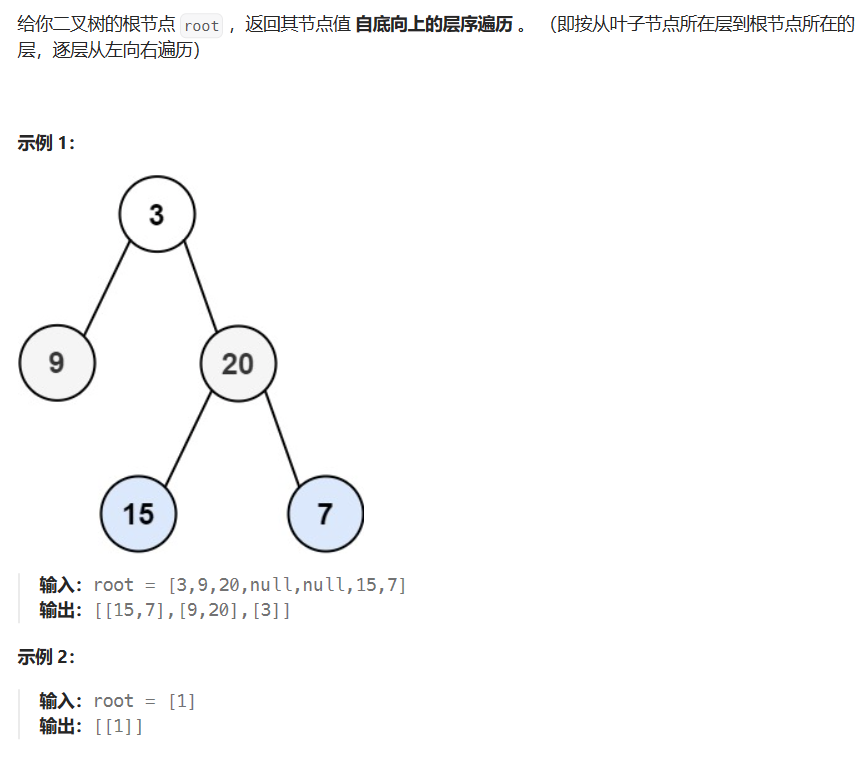
上一题reverse一下就可以了
class Solution {
public:void Recursion(vector<vector<int>>& ans,TreeNode* root,int level){if(!root)return;if(ans.size() <= level)ans.push_back(vector<int>());ans[level].push_back(root->val);Recursion(ans,root->left,level+1);Recursion(ans,root->right,level+1);}vector<vector<int>> levelOrderBottom(TreeNode* root) {vector<vector<int>> ans;Recursion(ans,root,0);reverse(ans.begin(),ans.end());return ans;}
};
也引入一下这题(上一题)的非递归写法
class Solution {
public:vector<vector<int>> levelOrderBottom(TreeNode* root) {queue<TreeNode*> que;if (root != NULL) que.push(root); //先放一个根节点vector<vector<int>> result;while (!que.empty()) {int size = que.size();vector<int> vec;for (int i = 0; i < size; i++) {TreeNode* node = que.front();que.pop();vec.push_back(node->val); //从前往后一个一个取if (node->left) que.push(node->left); //push进去当前层的下一层节点if (node->right) que.push(node->right); //同理}result.push_back(vec); //加入一层}reverse(result.begin(), result.end()); // 在这里反转一下数组即可return result;}
};
1.6 199-二叉树的右视图
199
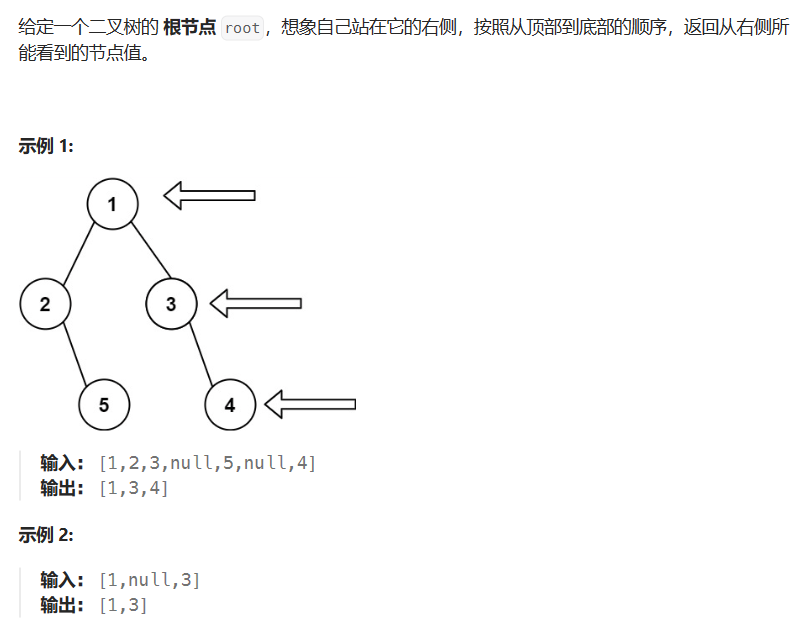
class Solution {
public:vector<int> rightSideView(TreeNode* root) {queue<TreeNode*> que;vector<int> ans;if(root) //加入第一个节点que.push(root);while(!que.empty()){int size = que.size();for(int i = 0; i < size;i++){TreeNode* tmp = que.front();que.pop();if(i == (size-1)) //如果是位于尾部ans.push_back(tmp->val);if(tmp->left)que.push(tmp->left);//加入下一层数据if(tmp->right)que.push(tmp->right);}}return ans;}
};
1.7* 637-二叉树的层平均值
637
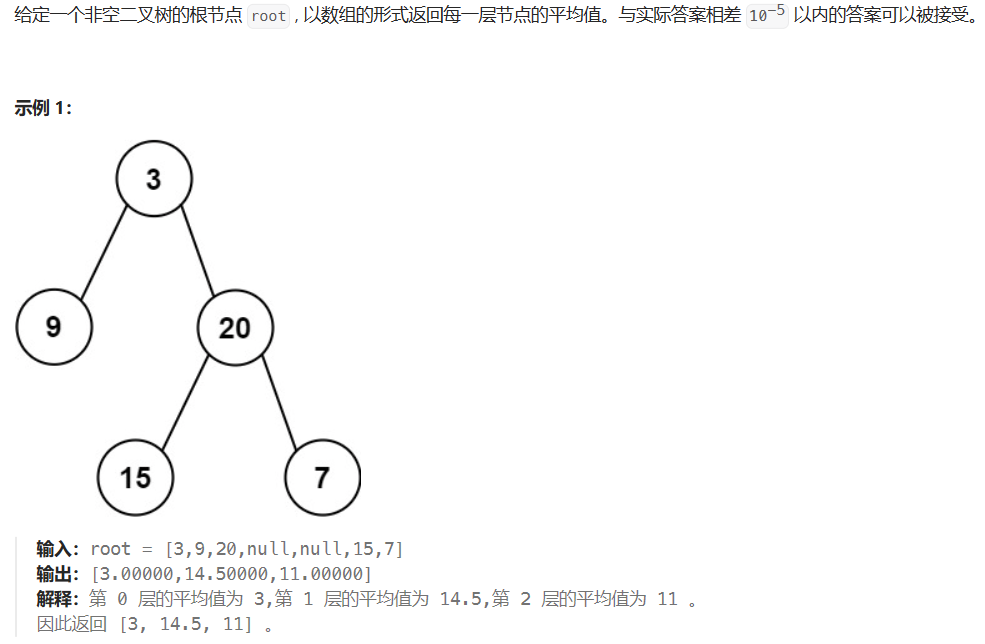
class Solution {
public:vector<double> averageOfLevels(TreeNode* root) {queue<TreeNode*> que;vector<double> ans;if(root)que.push(root);while(!que.empty()){int size = que.size();double sum = 0;for(int i = 0; i < size; ++i){TreeNode* tmp = que.front();que.pop();sum+=tmp->val;if(tmp->left)que.push(tmp->left);if(tmp->right)que.push(tmp->right);}ans.push_back(sum/size);}return ans;}
};
1.8* 429-N叉树的层序遍历
429
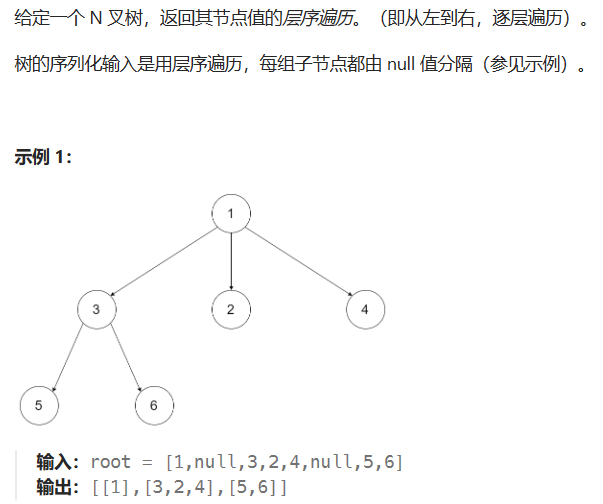
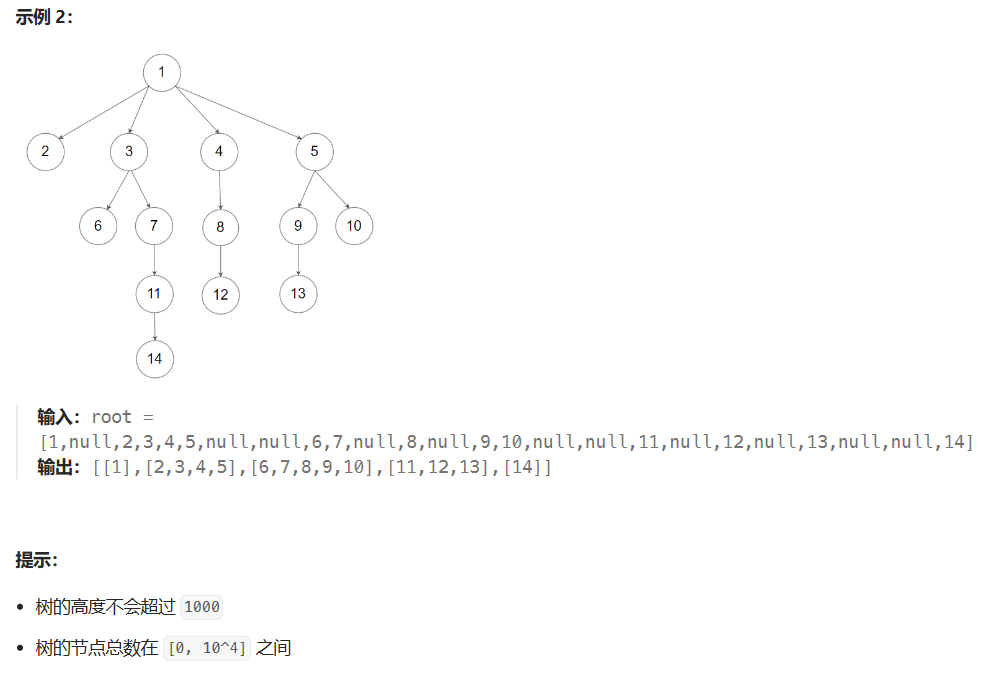
/*
// Definition for a Node.
class Node {
public:int val;vector<Node*> children;Node() {}Node(int _val) {val = _val;}Node(int _val, vector<Node*> _children) {val = _val;children = _children;}
};
*/class Solution {
public:vector<vector<int>> levelOrder(Node* root) {queue<Node*> que;vector<vector<int>> ans;if(root)que.push(root);while(!que.empty()){int size = que.size();vector<int> tmp_v;for(int i = 0; i < size; ++i){Node* node = que.front();que.pop();tmp_v.push_back(node->val);for(int j = 0; j < node->children.size(); ++j) //下一层节点加入queif(node->children[j])que.push(node->children[j]);}ans.push_back(tmp_v);}return ans;}
};
1.9 515-在每个树行中找最大值
515
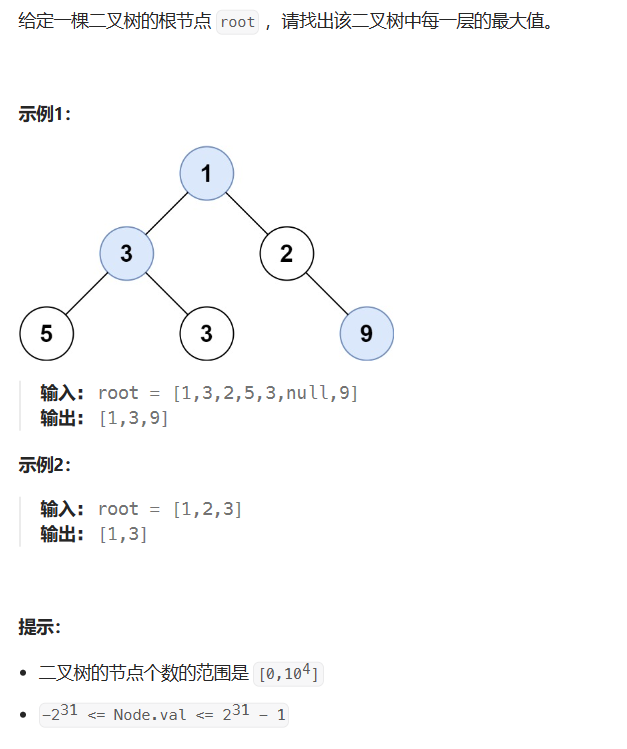
class Solution {
public:vector<int> largestValues(TreeNode* root) {vector<int> ans;queue<TreeNode*> que;if(root)que.push(root);while(!que.empty()){int size = que.size();int max = INT_MIN;for(int i = 0; i < size;++i){TreeNode* tmp = que.front();que.pop();if(tmp->val>max)max = tmp->val;if(tmp->left)que.push(tmp->left);if(tmp->right)que.push(tmp->right);}ans.push_back(max);}return ans;}
};
1.10* 116-填充每个节点的下一个右侧节点指针
116
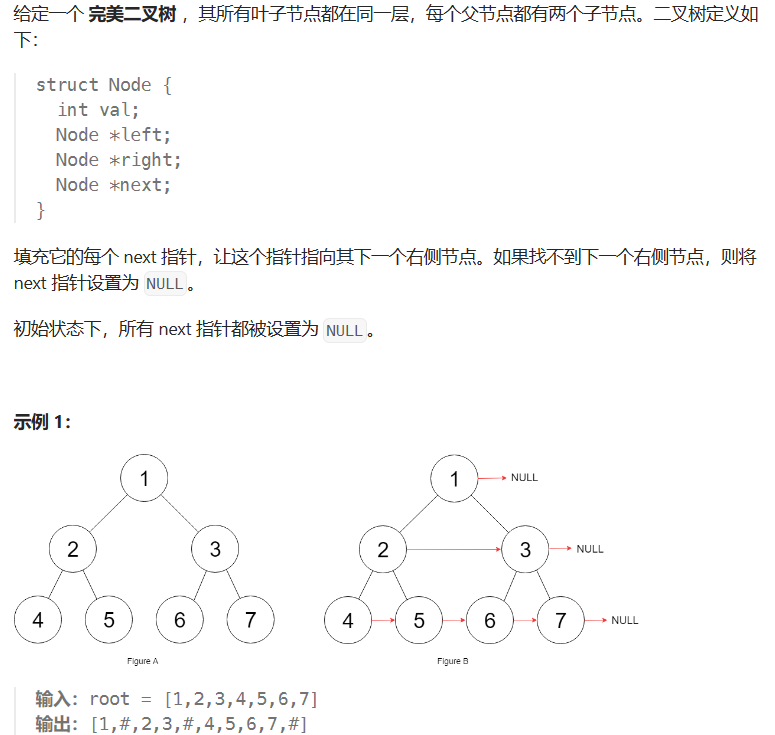

/*
// Definition for a Node.
class Node {
public:int val;Node* left;Node* right;Node* next;Node() : val(0), left(NULL), right(NULL), next(NULL) {}Node(int _val) : val(_val), left(NULL), right(NULL), next(NULL) {}Node(int _val, Node* _left, Node* _right, Node* _next): val(_val), left(_left), right(_right), next(_next) {}
};
*/class Solution {
public:Node* connect(Node* root) {if(!root)return nullptr;Node* leftest = root;while(leftest->left) //如果该节点还有子节点,则说明可以进入循环处理其孩子{Node* cur = leftest;while(cur) //处理cur所有的子节点连接 {cur->left->next = cur->right; //下一层的next连接if(cur->next)cur->right->next = cur->next->left; //下一层隔支连接cur = cur->next;}leftest = leftest->left; //下一层最左边开始}return root;}
};
若使用普通的层序遍历那么空间复杂度会达到N
而这种方式空间复杂度为1
1.11 117-填充每个节点的下一个右侧节点指针II
117
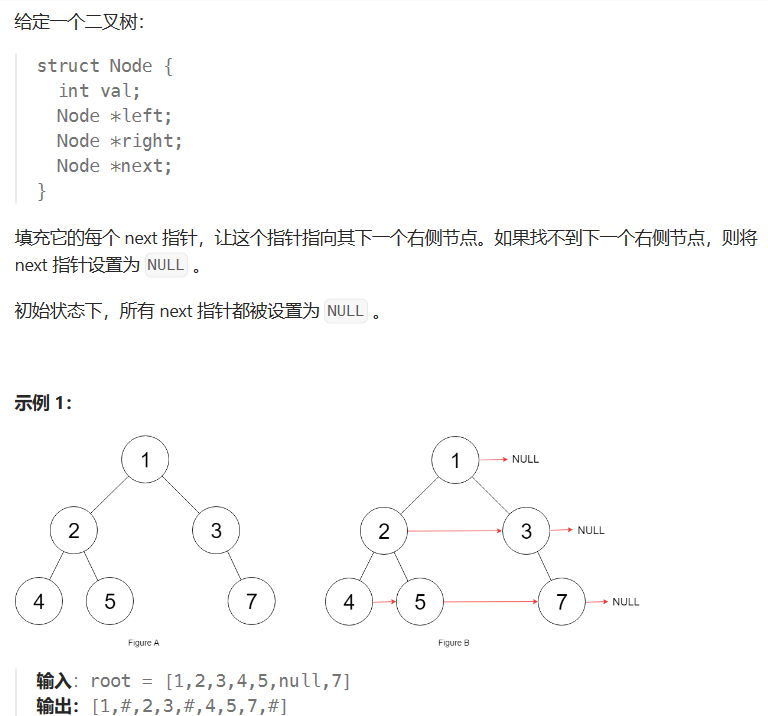

上一题是完全二叉树
/*
// Definition for a Node.
class Node {
public:int val;Node* left;Node* right;Node* next;Node() : val(0), left(NULL), right(NULL), next(NULL) {}Node(int _val) : val(_val), left(NULL), right(NULL), next(NULL) {}Node(int _val, Node* _left, Node* _right, Node* _next): val(_val), left(_left), right(_right), next(_next) {}
};
*/class Solution {
public:Node* connect(Node* root) {if(root && (root->left || root->right)) //root存在并且必须有一个孩子{if(root->left && root->right) //如果有左有右,则连接孩子root->left->next = root->right;//准备让孩子隔支连接Node* child = root->right ? root->right : root->left;Node* brodady = root->next; //向右移动以便用孩子连接childwhile(brodady && !(brodady->left||brodady->right)) //直到brodady走到尽头,也要找到有孩子的brodadybrodady = brodady->next;child->next = brodady ? (brodady->left ? brodady->left : brodady->right) : nullptr;connect(root->right); //先向右初始化出NULLconnect(root->left);}return root;}
};
1.12 104-二叉树的最大深度
104
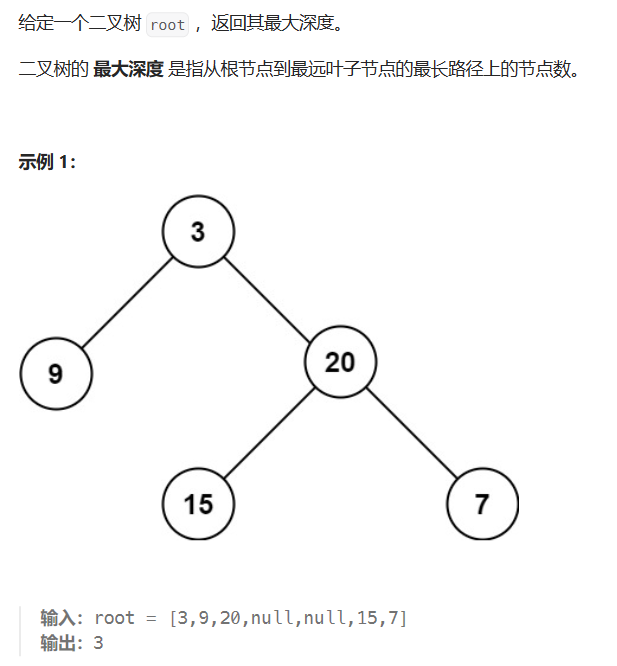
class Solution {
public:int maxDepth(TreeNode* root) {if(!root)return 0;return max(maxDepth(root->left), maxDepth(root->right)) + 1;}
};
1.13 111-二叉树的最小深度
111
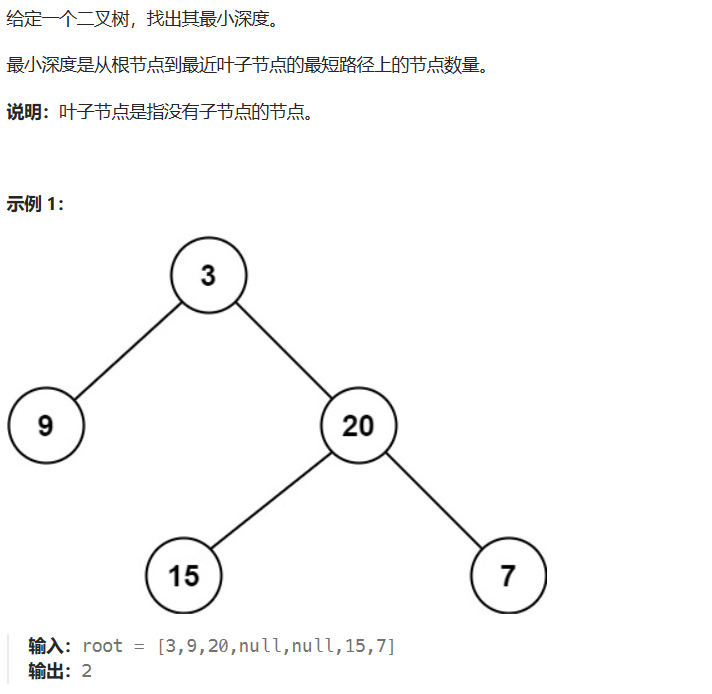
class Solution {
public:int minDepth(TreeNode* root) {if(!root)return 0;if(!root->left && !root->right)return 1;int min_depth = INT_MAX;if(root->left)min_depth = min(minDepth(root->left),min_depth);if(root->right)min_depth = min(minDepth(root->right),min_depth);return min_depth+1;}
};
2. 二叉树之常见算法
2.1 226-翻转二叉树
226
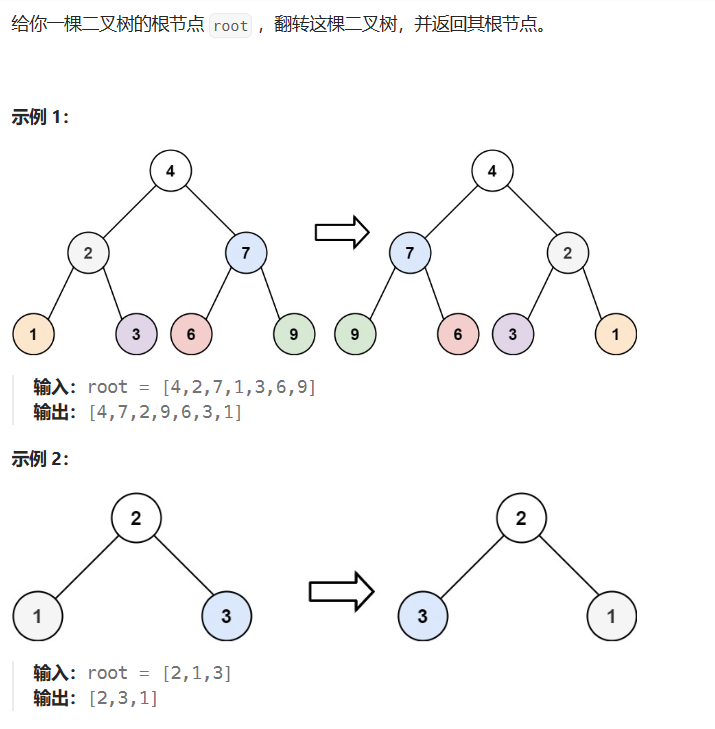
class Solution {
public:TreeNode* invertTree(TreeNode* root) {if(!root)return nullptr;swap(root->left,root->right);invertTree(root->left);invertTree(root->right);return root;}
};
2.2 101-对称二叉树
101

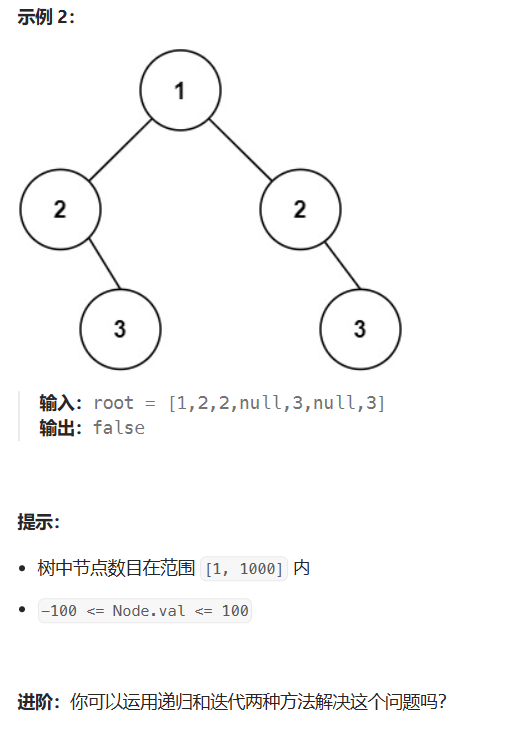
递归
class Solution {
public:bool Recursion(TreeNode* left,TreeNode* right){if(!left&&right || left&&!right) //如果长短不一return false;if(!left && !right) //如果都没有后续了return true;if(left->val != right->val)return false;return Recursion(left->left,right->right) &&Recursion(left->right,right->left); //对称的两个节点比较}bool isSymmetric(TreeNode* root) {return Recursion(root->left,root->right);}
};
迭代(栈)
class Solution {
public:bool isSymmetric(TreeNode* root) {stack<TreeNode*> st;st.push(root->left);st.push(root->right);while (!st.empty()) {TreeNode* leftNode = st.top(); st.pop();TreeNode* rightNode = st.top(); st.pop();if (!leftNode && !rightNode) //左右节点都不存在,相当于对称,循环至下一次判断continue;//左右不一样长 || 左右节点的值不一样if ((!leftNode || !rightNode || (leftNode->val != rightNode->val))) return false;st.push(leftNode->left);st.push(rightNode->right);st.push(leftNode->right);st.push(rightNode->left);}return true;}
};
2.3* 222-完全二叉树的节点个数
222
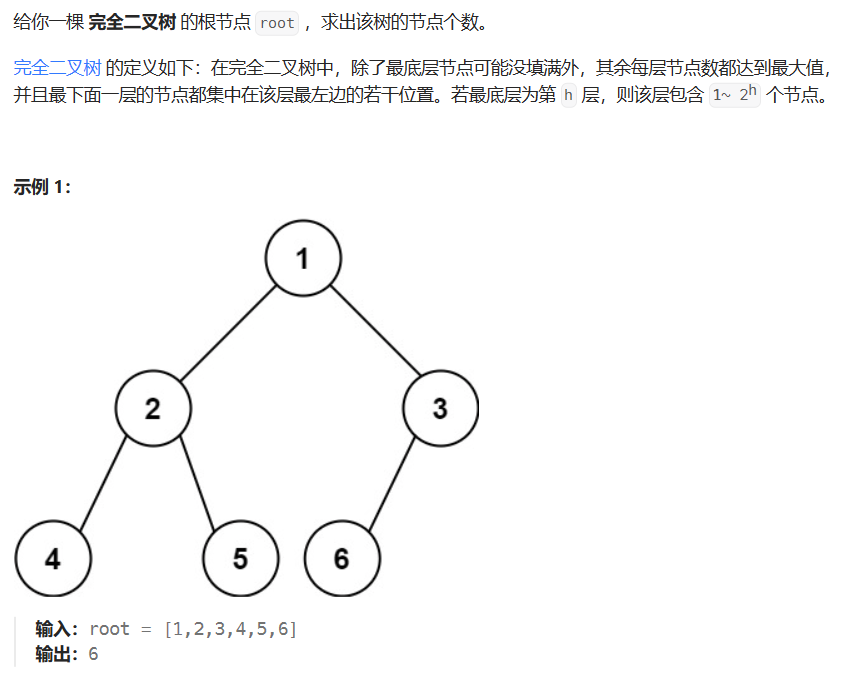
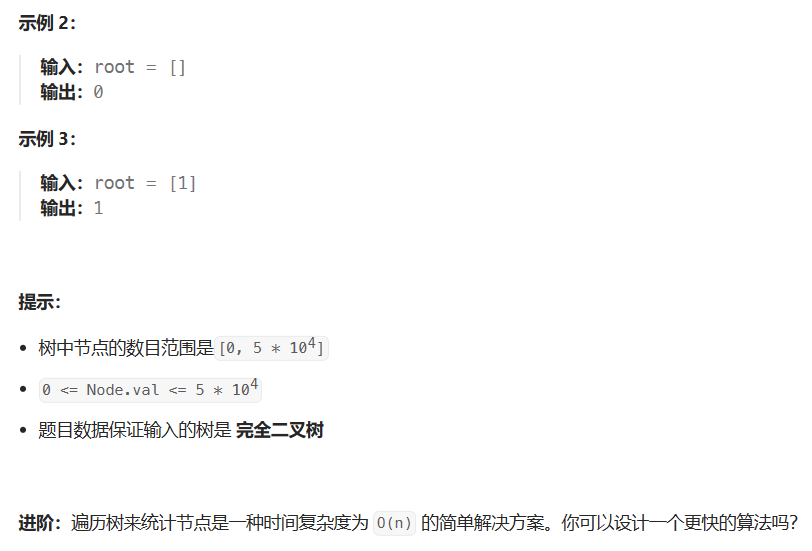
递归遍历 O(N)
class Solution {
public:void Recursion(TreeNode* root,int& count){if(!root)return;count++;Recursion(root->left,count);Recursion(root->right,count);}int countNodes(TreeNode* root) {int count = 0;Recursion(root,count);return count;}
};
精简版递归
class Solution {
public:int countNodes(TreeNode* root) {if (root == NULL) return 0;return 1 + countNodes(root->left) + countNodes(root->right);}
};
最优
class Solution {
public:int countNodes(TreeNode* root) {if (!root)return 0;int level = 0;TreeNode* cur = root;while (cur->left) {level++;cur = cur->left;}int low = 1 << level; // 层序遍历第low位为最深层最左侧节点序号 4int high = (1 << (level + 1)) - 1; //层序遍历第high位为最深层最右侧节点序号 7while (low < high) {int mid = (high - low + 1) / 2 + low; //+1防止low+0 ,mid为两节点中间部分一个节点,偏右if (exists(root, level, mid))low = mid;elsehigh = mid - 1;}return low;}bool exists(TreeNode* root, int level, int mid) //6{int bits = 1 << (level - 1); //上一层的第一位序列TreeNode* cur = root;while (cur && bits > 0) {if (bits & mid) //0010 0110 0010 当不再同一树时判断后就进入循环cur = cur->right;elsecur = cur->left;bits >>= 1; //bits是最左节点,往上靠}return cur != nullptr;}
};
时间复杂度:O(logN*logN)
空间复杂度:O(1)
2.4 110-平衡二叉树
110
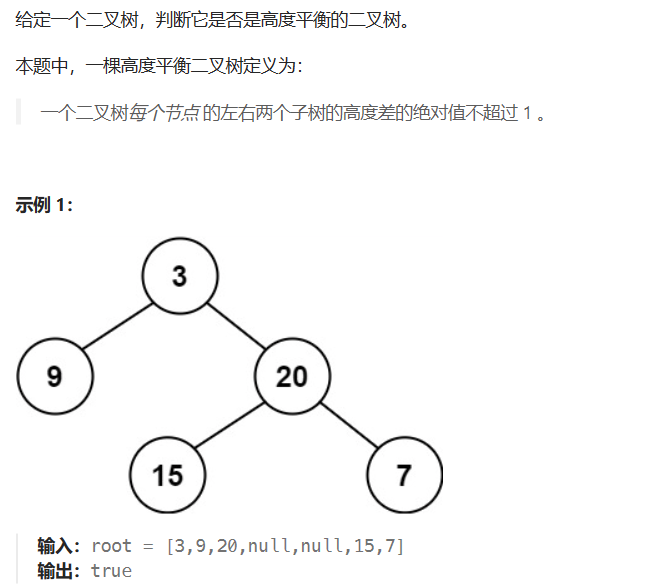

class Solution {
public:int Recursion(TreeNode* root){if(!root)return 0;int left = Recursion(root->left);if(left == -1)return -1;int right = Recursion(root->right);if(right == -1)return -1;if(abs(left-right) > 1)return -1; //执行后,以后的结果都为-1,递归其实已经可以看作结束了return left>right?left+1:right+1; //每一层都会记录层数+1}bool isBalanced(TreeNode* root) {if(Recursion(root) == -1)return false;return true; }
};
2.5 257-二叉树的所有路径
257
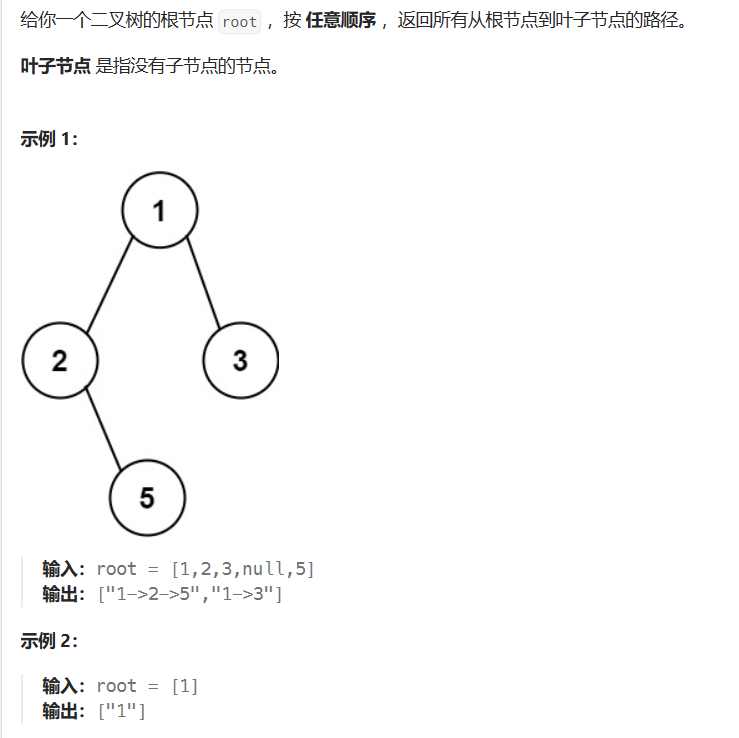

class Solution {
public:void Recursion(TreeNode* root,vector<string>& vs,string s) //s传的是临时拷贝份{if(root&&!root->left&&!root->right) //无子,此时不加->{s+=(to_string(root->val));vs.push_back(s);return;}if(!root)return;s+=(to_string(root->val)+"->");Recursion(root->left,vs,s); Recursion(root->right,vs,s); }vector<string> binaryTreePaths(TreeNode* root) {vector<string> vs;string s;Recursion(root,vs,s);return vs;}
};
2.6 404-左子叶之和
404
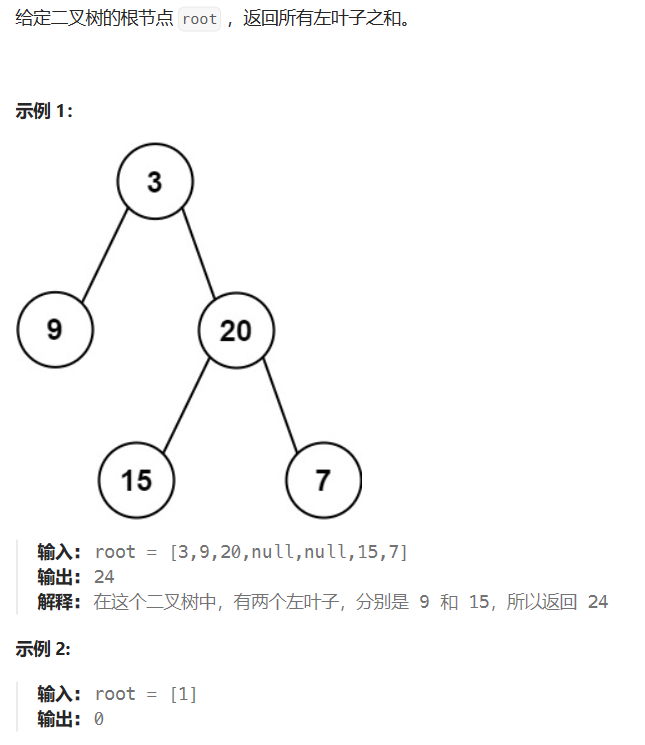
class Solution {
public:int sumOfLeftLeaves(TreeNode* root) {if (!root) return 0;int leftValue = 0;if (root->left && !root->left->left && !root->left->right) //左子存在且为叶leftValue = root->left->val;return leftValue + sumOfLeftLeaves(root->left) + sumOfLeftLeaves(root->right);}
};
2.7* 513-找树左下角的值
513

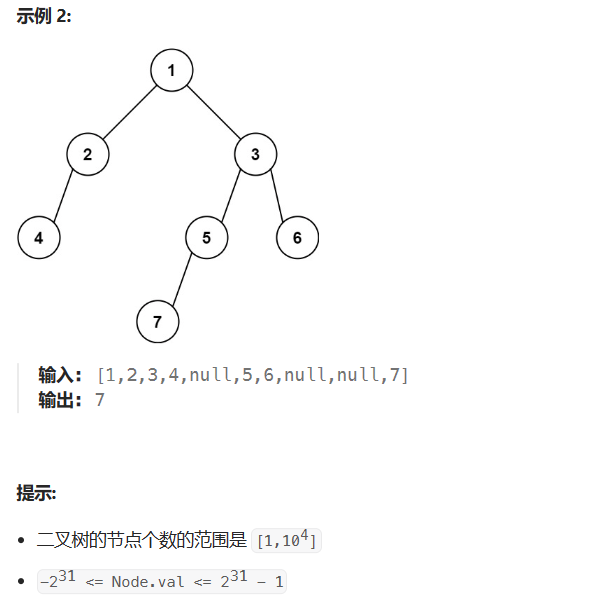
dfs
class Solution {
public:void Recursion(TreeNode* cur,int curdep,int& maxdep,int& ans){if(!cur->left&&!cur->right){if(curdep>maxdep){maxdep = dep;ans = cur->val;}return;}if(cur->left) //cur->left在前面使得更早的占用ans,以防被right占用Recursion(cur->left,dep+1,maxdep,ans);if(cur->right)Recursion(cur->right,dep+1,maxdep,ans);}int findBottomLeftValue(TreeNode* root) {int ans = root->val;int maxdep = 0;Recursion(root,0,maxdep,ans);return ans;}
};
bfs
class Solution {
public:int findBottomLeftValue(TreeNode* root) {int ans = 0;queue<TreeNode*> que;que.push(root);while(!que.empty()){TreeNode* cur = que.front();que.pop();if(cur->right)que.push(cur->right);if(cur->left)que.push(cur->left);ans = cur->val;}return ans;}
};
2.8 112-路径总和
112
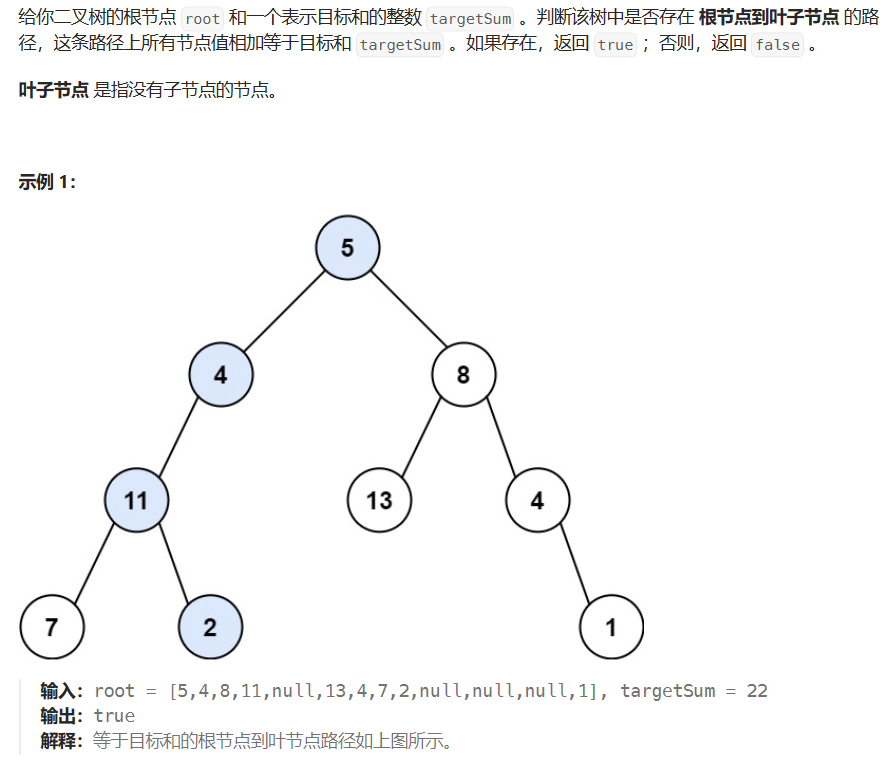
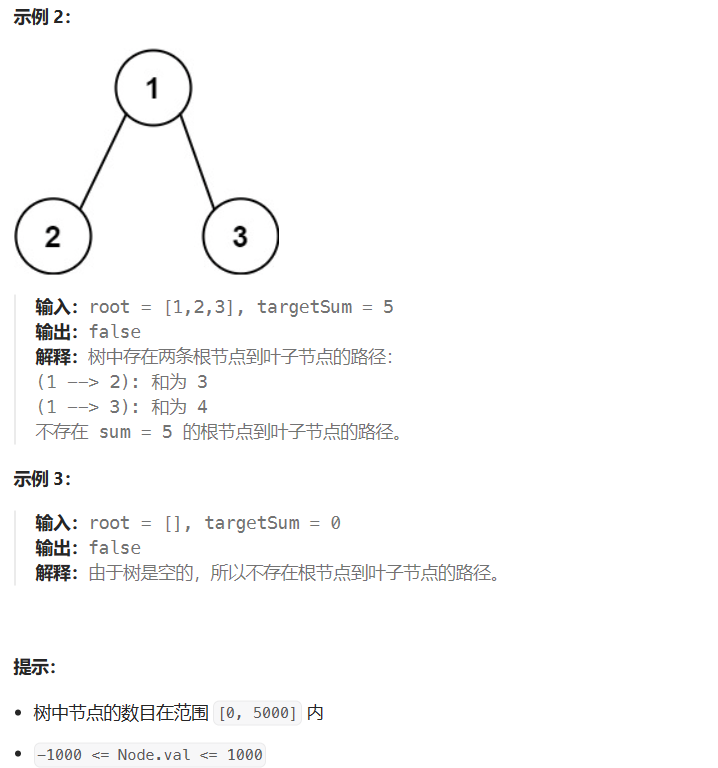
class Solution {
public:bool Recursion(TreeNode* cur,int sum,int target){if(!cur)return false;if(!cur->left&&!cur->right&&sum+cur->val == target)return true;return Recursion(cur->left,sum+cur->val,target)||Recursion(cur->right,sum+cur->val,target);}bool hasPathSum(TreeNode* root, int targetSum) {return Recursion(root,0,targetSum);}
};
2.9* 106-从中序与后续遍历序列构造二叉树
106

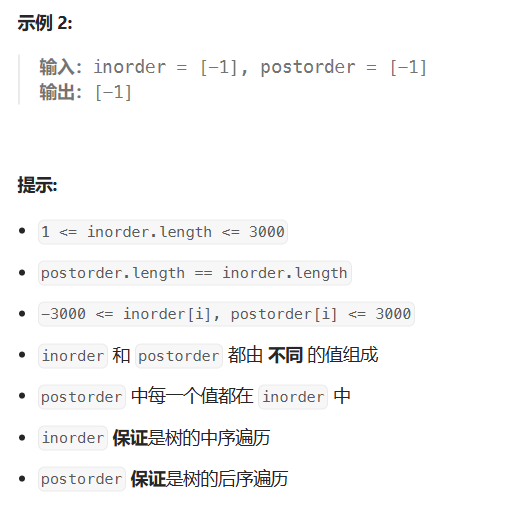
class Solution {
public:TreeNode* Recursion(vector<int>& inorder,vector<int>& postorder,int& rootindex,int left,int right){if(left > right)return nullptr;TreeNode* cur = new TreeNode(postorder[rootindex]); //cur为当前根节点int mid = 0;for(mid = inorder.size()-1 ; mid >=0 ; --mid)if(inorder[mid] == postorder[rootindex])break;//此时mid为inorder的根坐标rootindex--; //跳到下一个根//因为是后序所以先right,否则会出现构建出相反的树,并且大概率导致rootindex<0而导致的越栈cur->right = Recursion(inorder,postorder,rootindex,mid+1,right);cur->left = Recursion(inorder,postorder,rootindex,left,mid-1);return cur;}TreeNode* buildTree(vector<int>& inorder, vector<int>& postorder) {int rootindex = postorder.size() - 1;return Recursion(inorder,postorder,rootindex,0,rootindex);}
};
2.10* 105-从前序与中序遍历序列构造二叉树
105
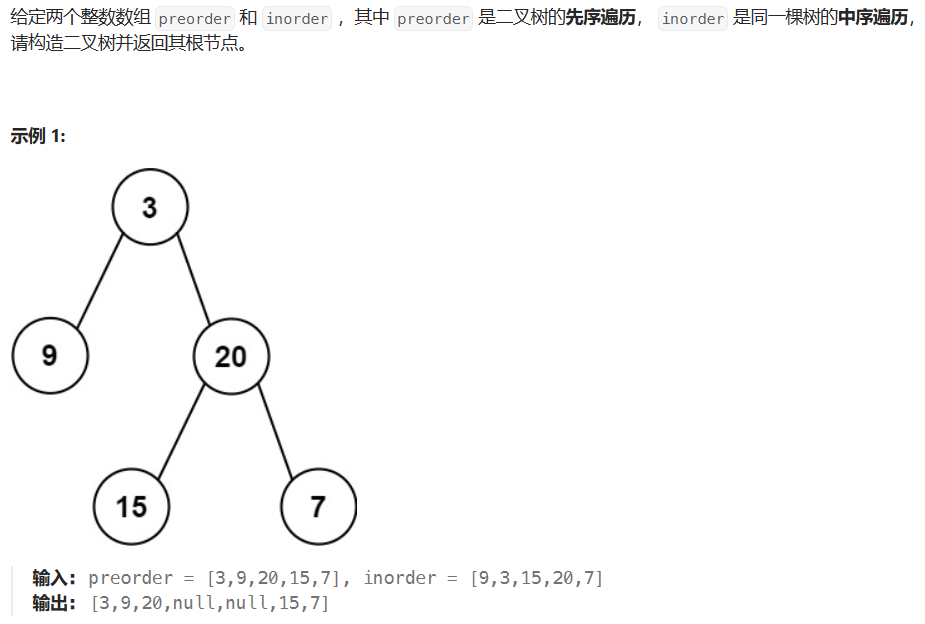

class Solution {
public:TreeNode* Recursion(vector<int>& preorder, vector<int>& inorder,int& rootindex,int left , int right){if(left > right)return nullptr;TreeNode* cur = new TreeNode(preorder[rootindex]);int mid = 0;for(mid = 0 ; mid < inorder.size() ; ++mid)if(inorder[mid] == preorder[rootindex])break;rootindex++;cur->left = Recursion(preorder,inorder,rootindex,left,mid-1);cur->right = Recursion(preorder,inorder,rootindex,mid+1,right);return cur;}TreeNode* buildTree(vector<int>& preorder, vector<int>& inorder) {int rootindex = 0;return Recursion(preorder,inorder,rootindex,0,preorder.size()-1);}
};
2.11* 654-最大二叉树
654

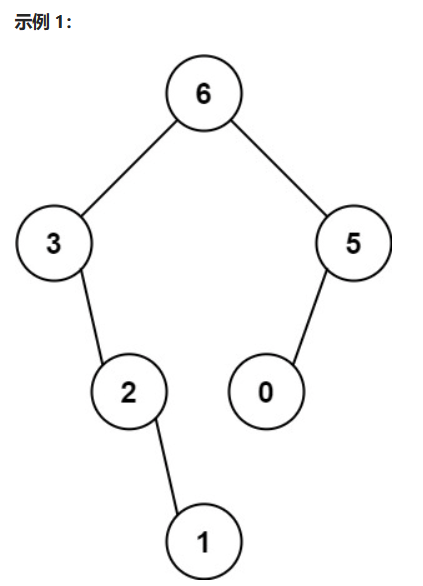

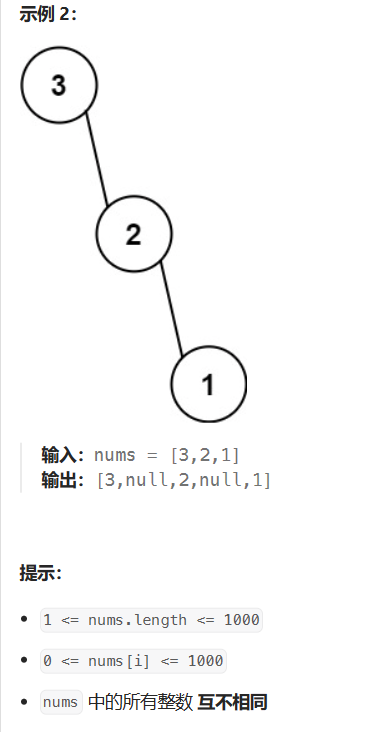
class Solution {
public:TreeNode* Recursion(vector<int>& nums,int left,int right){if(left > right)return nullptr;int mid = left; //坐标int max = 0; //最大值for(int i = mid ; i <= right ; ++i){if(nums[i] > max){mid = i; //mid就是根的坐标max = nums[i]; //最大值就是根}}TreeNode* cur = new TreeNode(max); //构建根cur->left = Recursion(nums,left,mid-1);cur->right = Recursion(nums,mid+1,right);return cur;}TreeNode* constructMaximumBinaryTree(vector<int>& nums) {return Recursion(nums,0,nums.size()-1);}
};
2.12 617-合并二叉树
617
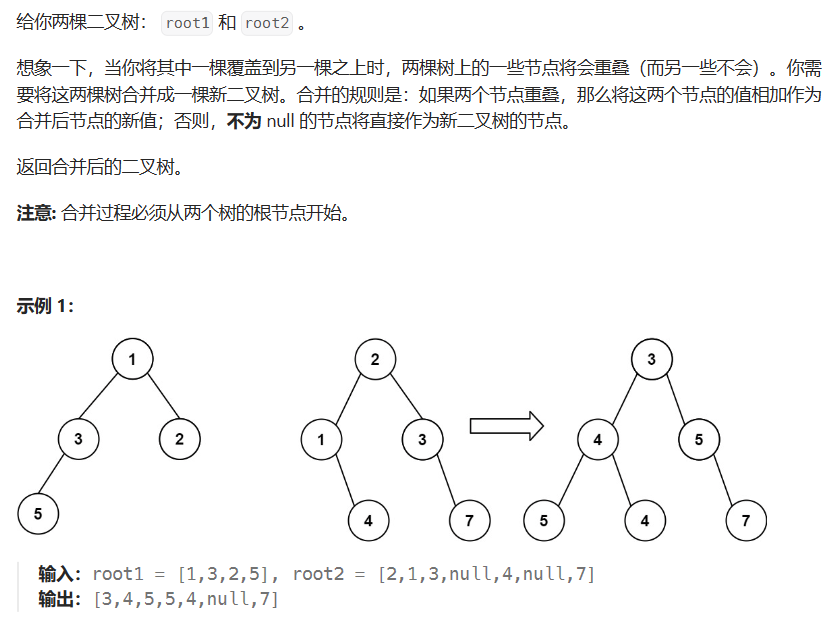
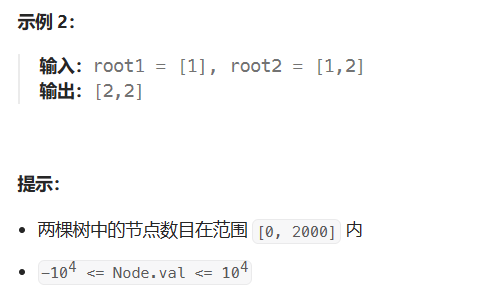
class Solution {
public:TreeNode* mergeTrees(TreeNode* root1, TreeNode* root2) {if(!root1)return root2; //如果两个节点都不存在,也会返回nullptr(root2)if(!root2)return root1;TreeNode* root = new TreeNode(root1->val+root2->val);root->left = mergeTrees(root1->left,root2->left);root->right = mergeTrees(root1->right,root2->right);return root;}
};
2.13* 236-二叉树的最近公共祖先
236
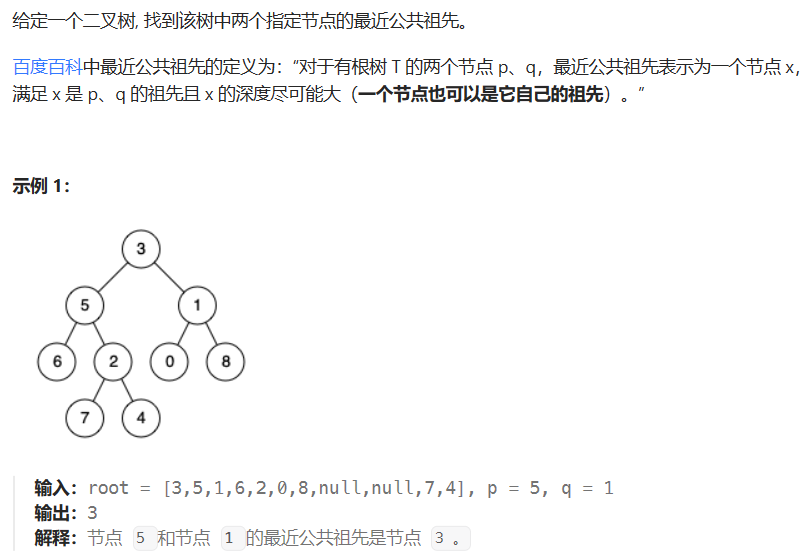
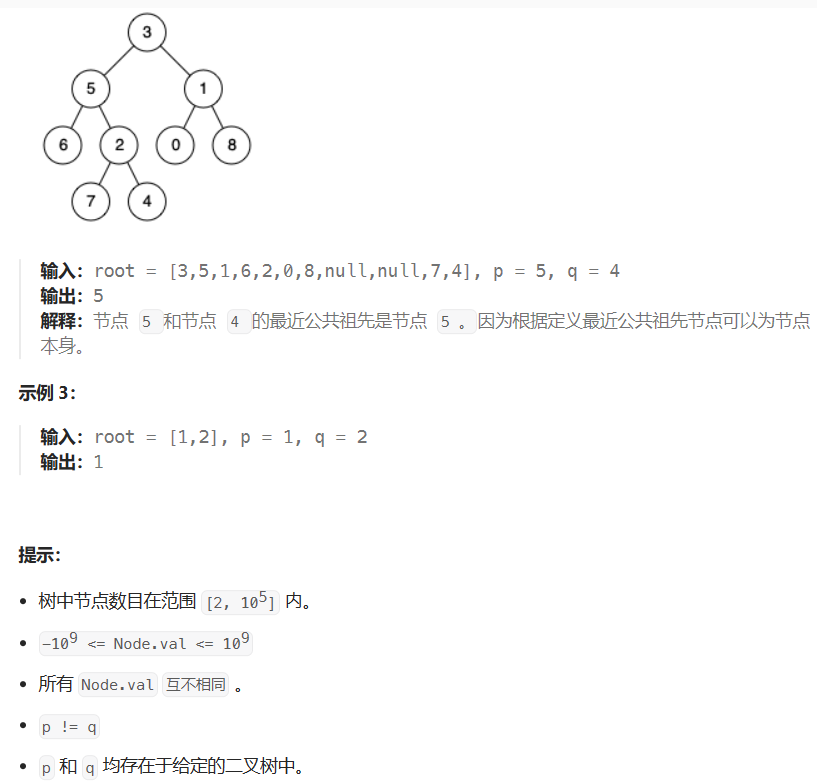
/*** Definition for a binary tree node.* struct TreeNode {* int val;* TreeNode *left;* TreeNode *right;* TreeNode(int x) : val(x), left(NULL), right(NULL) {}* };*/
class Solution {
public:TreeNode* lowestCommonAncestor(TreeNode* root, TreeNode* p, TreeNode* q) {if(!root)return nullptr;if(root == p || root == q)return root;TreeNode* left = lowestCommonAncestor(root->left,p,q);TreeNode* right = lowestCommonAncestor(root->right,p,q);if(left&&right)return root;else if(!left&&right)return right;else if(left&&!right)return left;elsereturn nullptr;}
};
3. 二叉搜索树
3.1 700-二叉搜索树中的搜索
700
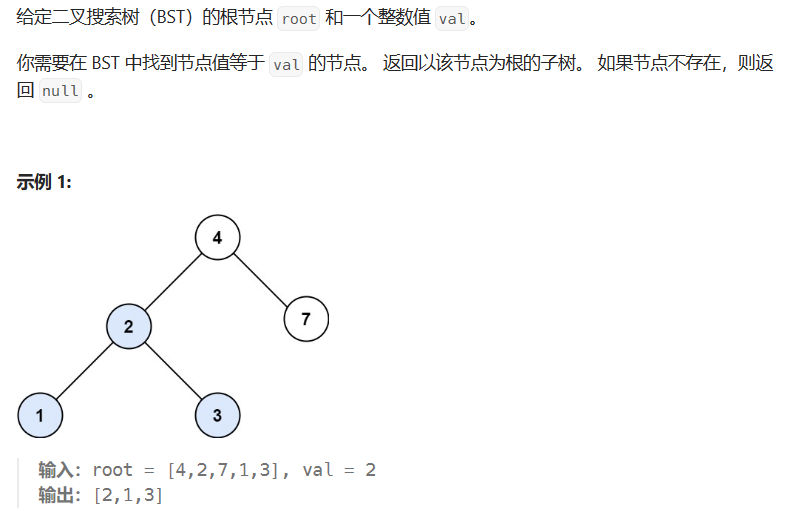
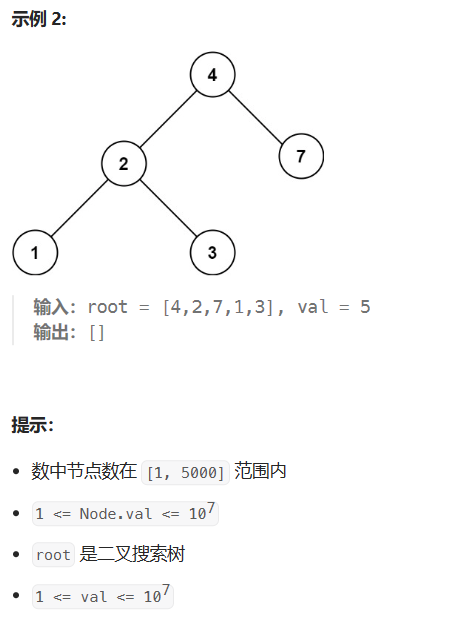
class Solution {
public:TreeNode* searchBST(TreeNode* root, int val) {if(!root)return nullptr;if(val < root->val)return searchBST(root->left,val);else if(val > root->val)return searchBST(root->right,val);elsereturn root;}
};
3.2* 98-验证二叉搜索树
98
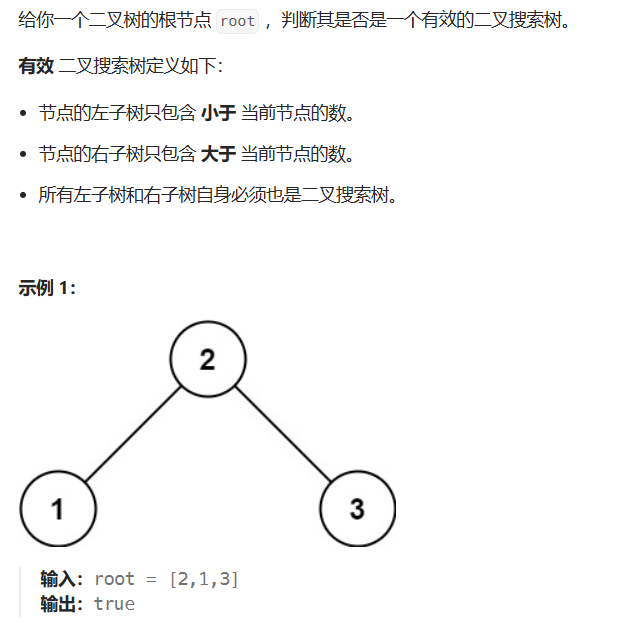
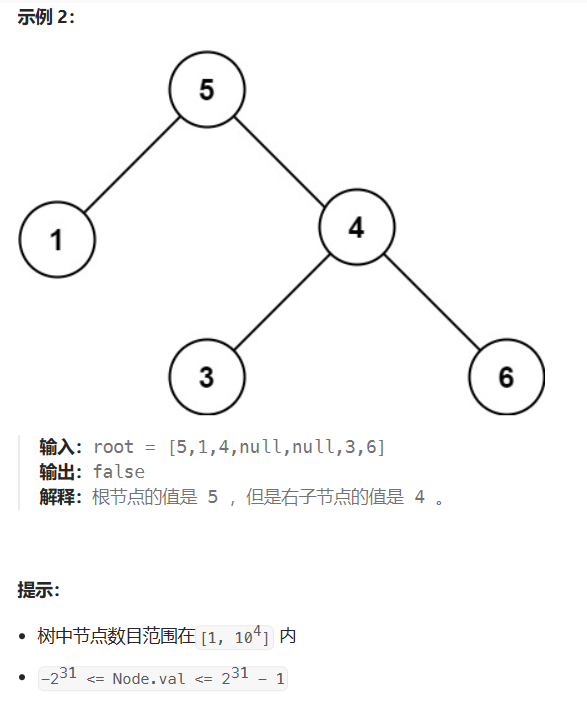
class Solution {
public:bool isValidBST(TreeNode* root,TreeNode* minNode = nullptr,TreeNode* maxNode = nullptr) {if(!root)return true;if((minNode && root->val <= minNode->val) || //右树用来判断是否比父小(maxNode && root->val >= maxNode->val)) //左树用来判断是否比父大return false; //不符合就falsereturn isValidBST(root->left,minNode,root) && //对于左树,最大的就是根isValidBST(root->right,root,maxNode); //对于右树,最小的就是根}
};
更直观的方法
class Solution {
public:bool isValidBST(TreeNode* root) {if(!root)return true;if(root->left){TreeNode* tmp = root->left;if(tmp->val>=root->val) //先判断和父的关系是否满足return false;while(tmp->right) //在判断自己的右孩子是否和自己对应{ //左孩子会通过递归(和父的关系)进行判断tmp = tmp->right;if(tmp->val>=root->val)return false;}}if(root->right){TreeNode* tmp = root->right;if(tmp->val<=root->val)return false;while(tmp->left){tmp = tmp->left;if(tmp->val<=root->val)return false;}}return isValidBST(root->left) && isValidBST(root->right);}
};
3.3 530-二叉搜索树的最小绝对差
530
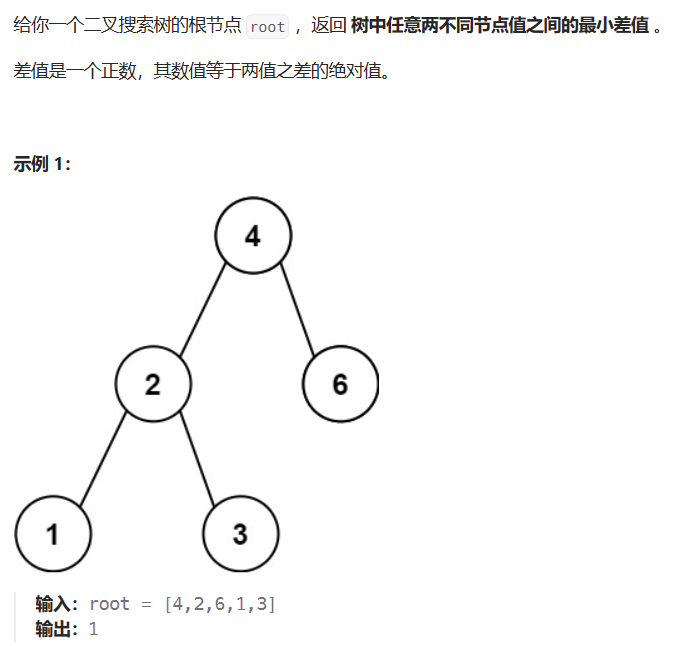

递归
class Solution {
public:void Recursion(TreeNode* root,TreeNode*& prev,int& mindif){if(!root)return;Recursion(root->left,prev,mindif);if(prev)mindif = min(mindif,abs(root->val-prev->val));prev = root; //prev就是更深层的Recursion(root->right,prev,mindif);}int getMinimumDifference(TreeNode* root) {int mindif = INT_MAX;TreeNode* prev = nullptr;Recursion(root,prev,mindif); //类似于采取中序遍历寻找mindifreturn mindif;}
};
完全遍历
class Solution {
public:void Recursion(TreeNode* root,int& min){if(!root)return;int tmp;if(root->left){TreeNode* left = root->left;while(left){tmp =abs(root->val-left->val);if(tmp<min)min = tmp;left = left->right;}}if(root->right){TreeNode* right = root->right;while(right){tmp = abs(root->val-right->val);if(tmp<min)min = tmp;right = right->left;}}Recursion(root->left,min);Recursion(root->right,min);}int getMinimumDifference(TreeNode* root) {int min = 100000;Recursion(root,min);return min;}
};
3.4 501-二叉搜索树中的众数
501
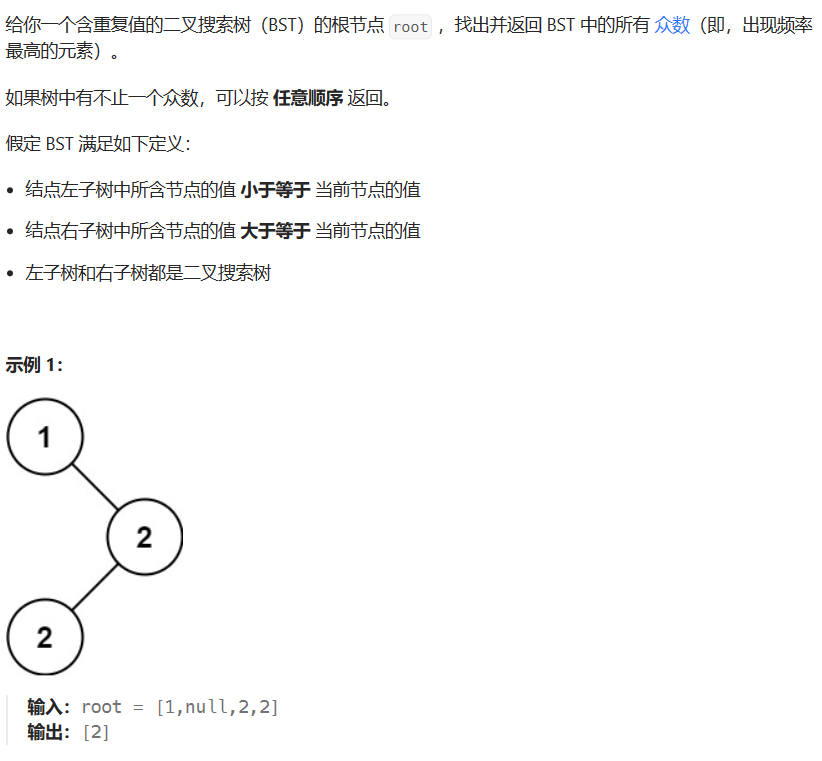
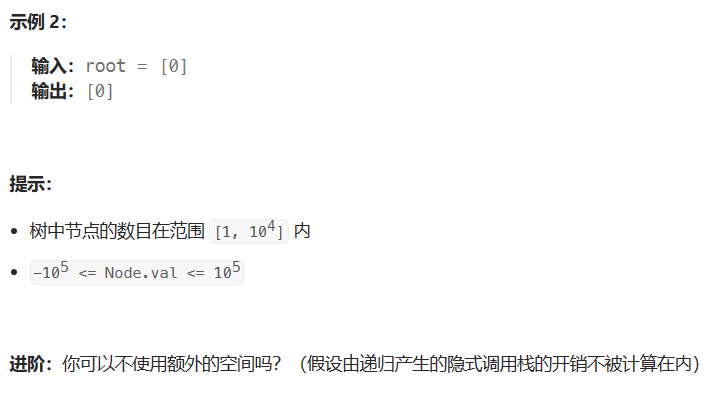
hash通解,即非二叉树也可解
class Solution {
public:void Init_um_Recursion(TreeNode* root,unordered_map<int,int>& um){if(!root)return;um[root->val]++;Init_um_Recursion(root->left,um);Init_um_Recursion(root->right,um);}vector<int> findMode(TreeNode* root) {unordered_map<int,int> um;Init_um_Recursion(root,um);vector<int> ans;int max = INT_MIN;for(auto& e : um) //算出最多的出现次数if(e.second > max)max = e.second;for(auto& e : um)if(e.second == max)ans.push_back(e.first);return ans;}
};
针对
/*** Definition for a binary tree node.* struct TreeNode {* int val;* TreeNode *left;* TreeNode *right;* TreeNode() : val(0), left(nullptr), right(nullptr) {}* TreeNode(int x) : val(x), left(nullptr), right(nullptr) {}* TreeNode(int x, TreeNode *left, TreeNode *right) : val(x), left(left), right(right) {}* };*/
class Solution {
public:int samenum = 0;int count = 0;int maxcount = 0;void Get_ret(TreeNode* root,vector<int>& ret){if(!root)return;Get_ret(root->left,ret);ret.push_back(root->val);if(samenum == root->val) //即使samenum初始值就和val相同也无所谓count++;else{samenum = root->val;count=1; //避免samenum初始就和val相同而导致的错误计数,也方便使用}if(maxcount < count)maxcount = count;Get_ret(root->right,ret);}vector<int> findMode(TreeNode* root) {vector<int> ans;vector<int> ret;Get_ret(root,ret);int left = 0;int right = maxcount-1; //left到right 可看作是窗口while(right < ret.size()){if(ret[left] == ret[right]){ans.push_back(ret[left]);left = right+1;right = left+maxcount-1;}else{left++;right++;}}return ans;}
};
3.5* 235-二叉搜索树的最近公共祖先
235


class Solution {
public:TreeNode* lowestCommonAncestor(TreeNode* root, TreeNode* p, TreeNode* q) {if(!root)return nullptr;if(root->val > p->val && root->val > q->val) //都在根右边return lowestCommonAncestor(root->left,p,q);else if(root->val<p->val&&root->val<q->val)return lowestCommonAncestor(root->right,p,q);return root;}
};
3.6* 701-二叉搜索树中的插入操作
701
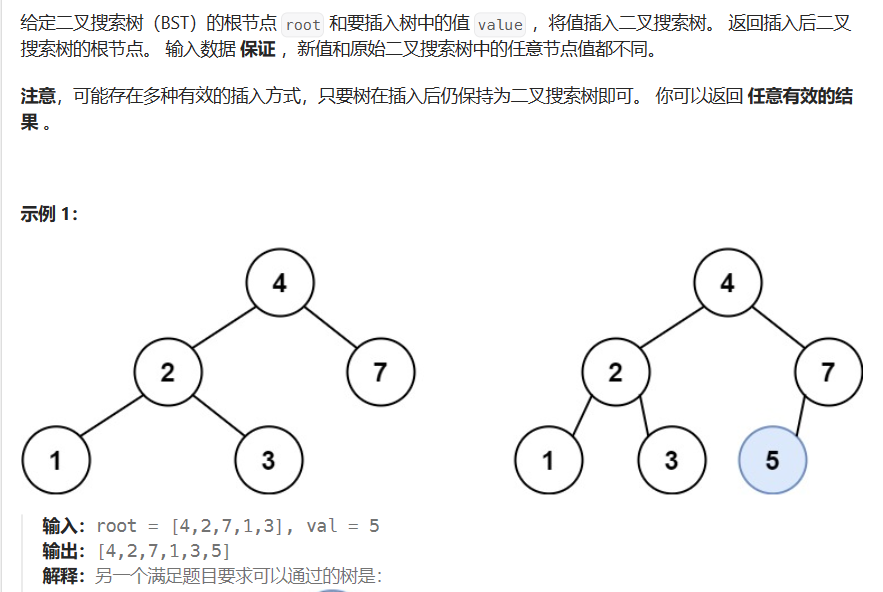
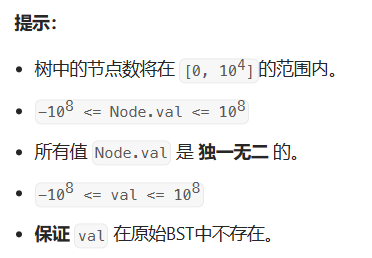
class Solution {
public:TreeNode* insertIntoBST(TreeNode* root, int val) {if(!root)return new TreeNode(val);if(val > root->val)root->right = insertIntoBST(root->right,val);else if(val < root->val)root->left = insertIntoBST(root->left,val);return root;}
};
3.7* 450-删除二叉搜索树中的节点
450
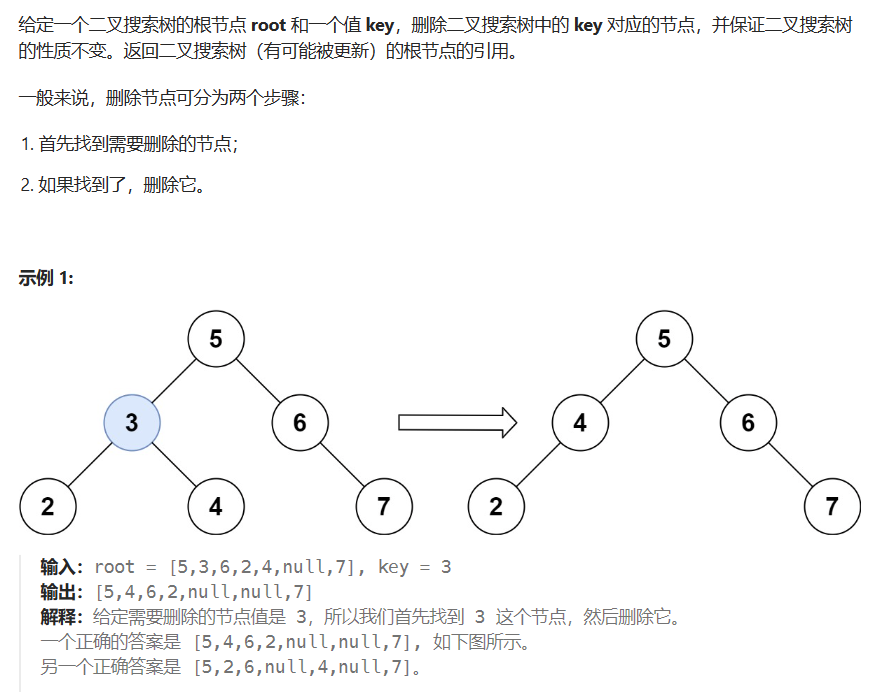
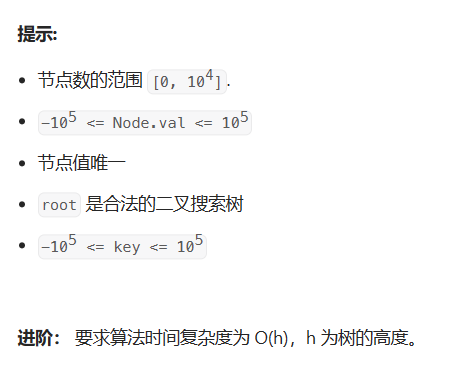
class Solution {
public:TreeNode* findMin(TreeNode* node) {while (node->left) node = node->left;return node;}TreeNode* deleteNode(TreeNode* root, int key) {if (!root) return root;if (key < root->val) root->left = deleteNode(root->left, key);else if (key > root->val) root->right = deleteNode(root->right, key);else {if (!root->left) {TreeNode* temp = root->right;delete root;return temp;}else if (!root->right) {TreeNode* temp = root->left;delete root;return temp;}TreeNode* temp = findMin(root->right); //temp就是要替代的节点root->val = temp->val;root->right = deleteNode(root->right, temp->val);}return root;}
};
3.8* 669-修剪二叉搜索树
669

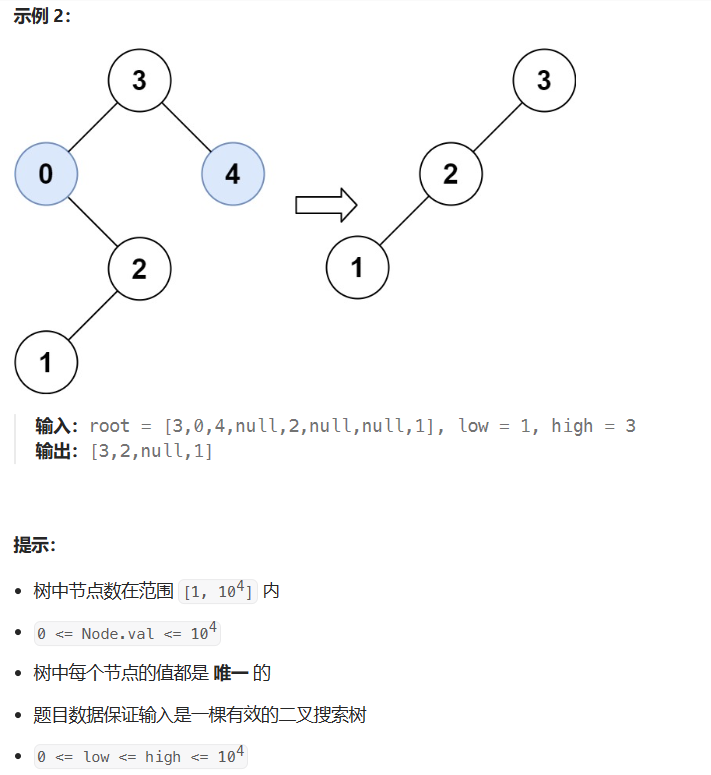
class Solution {
public:TreeNode* trimBST(TreeNode* root, int low, int high) {if(!root)return nullptr; //间接删除if(root->val<low) //范围全在右子树上return trimBST(root->right,low,high);if(root->val>high)return trimBST(root->left,low,high);root->left = trimBST(root->left,low,high);root->right = trimBST(root->right,low,high);return root;}
};
3.9 108-将有序数组转换为二叉搜索树
108
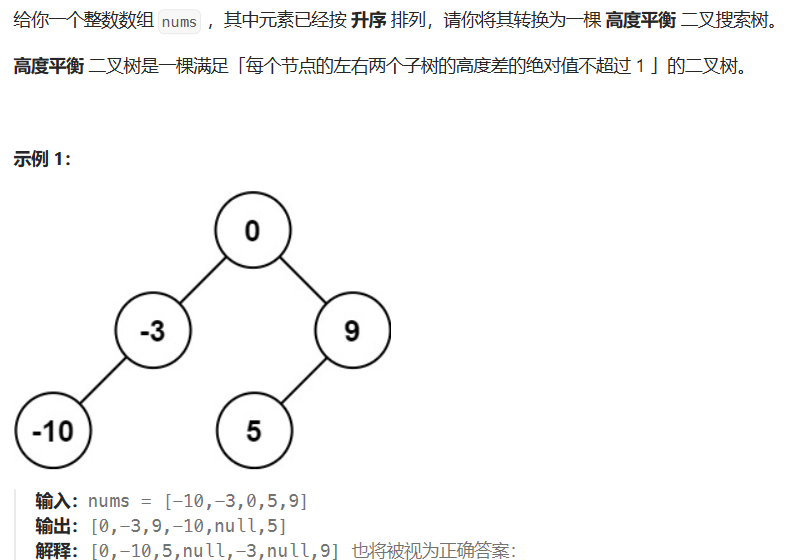
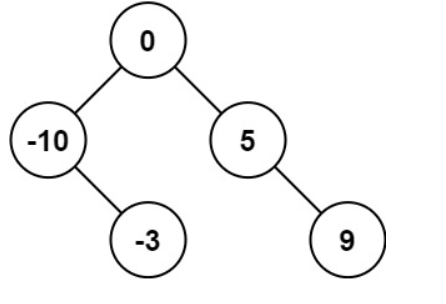
class Solution {
public:TreeNode* Recursion(vector<int>& nums,int left,int right){if(left>right)return nullptr;int mid = left+((right-left)>>1); // >>1 可看作是 /2,默认左偏TreeNode* newnode = new TreeNode(nums[mid]);newnode->left = Recursion(nums,left,mid-1);newnode->right = Recursion(nums,mid+1,right);return newnode;}TreeNode* sortedArrayToBST(vector<int>& nums) {return Recursion(nums,0,nums.size()-1);}
};
3.10 538-把二叉搜索树转换为累加树
538
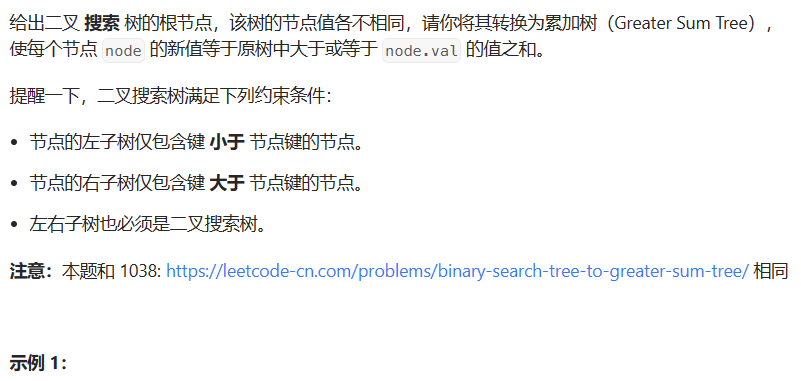
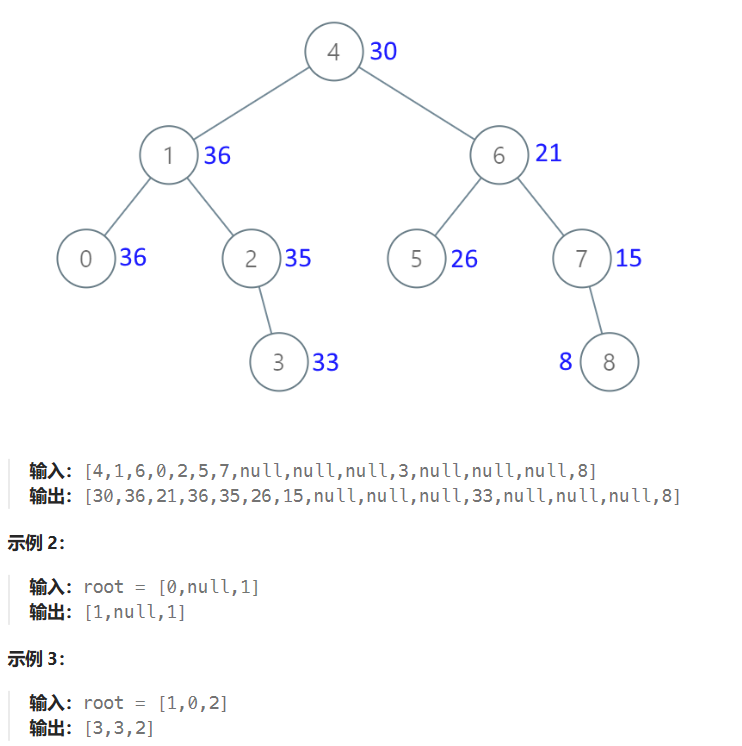

class Solution {
public:void Recursion(TreeNode* root,int& val){if(!root)return;Recursion(root->right,val);val+=root->val;root->val = val;Recursion(root->left,val);}TreeNode* convertBST(TreeNode* root) {int val = 0;Recursion(root,val);return root;}
};



)
)










-每天了解一点)

求解微电网优化MATLAB)

